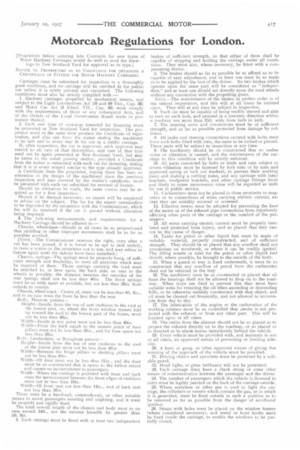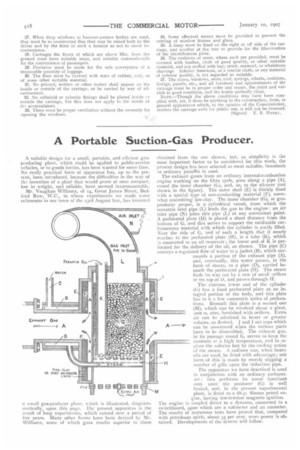Motorcab Regulations for London.
Page 21

Page 22

If you've noticed an error in this article please click here to report it so we can fix it.
[Proprietors before entering into Contracts for new types of Motor hackney Can-iages would do well to send the drawings to New Scotland Yard for approval as to type.]
NOTICE TO PROPRIETORS AS TO CONDITIONS FOR OBTAINING A CERTIFICATE OF FITNESS FOR MOTOR HACKNEY CARRIAGES.
Carriages must be submitted for inspection in a thoroughly good condition, and no carriage will be certified fit for public usc unless it is newly painted and varnished. The following conditions must also be strictly complied with : 1. Hackney carriages propelled by mechanical means, and subject to the Light Locomotives Act (59 and 60 Viet., Cap. 36) and Motor Car Act (3 Edved. VII., Cap. 36) must comply with the requirements of those or any subsequent .Acts, and of the Orders of the Local Government Board made in pursuance thereof.
2. Each new type of motorcar intended for licensing must be presented at New Scotland Yard for inspection. The proprietor must at the same time produce the Certificate of registration, and also one from the maker stating the machinery to be safe and in every way fit for use in a public carriage. If, after inspection, the car is approved, such approval may extend to all cars of that description, and cars of that type need not be again presented at New Scotland Yard, but may be taken to the usual passing station, provided a Certificate from the maker is submitted with each car for licensing, stating that it is in every respect similar to the type already approved.
A Certificate from the proprietor, stating there has been no alteration in the design of the machinery since the previous inspection and date covered by the maker's certificate, must be presented with each car submitted for renewal of license.
Should an alteration be made, the same course may be required as for a first inspection. Should it be deemed necessary, an expert will be employed to advise on the subject. The fee for the expert examination to be deposited by the proprietor with the Commissioner, which fee will be returned if the car is passed without alteration being required.
3. The follewing measurements and requirements fur a Hackney Carriage should be adhered to : Chassis, wheel-base-Should in all cases be so proportioned that skidding or other improper movements shall be as far as possible avoided.
(NOTE.-The Commissioner reserves the right, even after a car has been passed, if it is found to be apt to skid unduly, to issue a notice on the proprietor not to use, and may refuse to license again until the defects have been remedied.) Chassis, springs-The springs must be properly hung, of sufficient strength and flexibility, to meet all purposes which may be required of them. Those springs carrying the load must be attached to, or bear upon, the back axle, as near to the wheels as possible, the distance between the outsides of the rear springs shall not be less than 40in. The front springs must be as wide apart as possible, but not less than 26in. from outside to outside.
Chassis, wheel track Centre of, must not be less than 4ft. 4in., and in no case must the front be less than the rear.
Body, Hansom pattern Height-Inside, from the top of scat cushions to the roof at the lowest part, or, where the front window frames fold up toward the roof to the lowest part of the frame, must not be less than 40in.
Width-Inside at any point must not be less than 40in. Width-From the back squab to the nearest point of door pillars must not be less than 26in., and for knee space not less than 23in.
Bodv, Landaulette, or Brougham pattern He:ght-Inside from the top of seat cushions to the roof
at the lowest part must not be less than 40in. Width-Between the hinge pillars or shutting pillars must
not be Jess than 4flin.
Width-Of door must not be less than 21in., and the door most he so constructed that it opens to the fullest extent and causes no inconvenience to passengers. WidthWhere the carriage is provided with front and back seats the measurement between the front edges of cushions must not be less than 19in.
Width-Of front seat not less than 14in., and of back seat not less than 16in.
There must be a hand-rail, commode-rail, or other suitable means to assist passengers entering and alighting, and it must be properly and rigidly fixed. The total overall length of the chassis and body must in no case exceed 14ft., nor the extreme breadth be greater than 5ft. 9in.
4. Each carriage must be fitted with at least two independent brakes of sufficient strength, so that either of them shall be capable of stopping and holding the carriage under all conditions. They must also where necessary, be fitted with a compensating device. 5. The brakes should as far as possible be so affixed as to be capable of easy adjustment, and at least one must be so made as to be applied by the foot of the driver. No two brakes which operate upon the same part will be considered as "independent," and at least one should act directly upon the road wheels without any connection with the propelling gears.
NOTE.-The maintenance of the brakes in perfect order is of the utmost importance, and this will at all times be insisted upon. They will at any time be subject to inspection.
6. Each car must be capable of being readily steered and able to turn on each lock, and proceed in a contrary direction within a roadway not more than 25ft. wide from kerb to kerb. 7. The steering arms and connections must be of sufficient strength, and as far as possible protected from damage by collision.
8. All brake and steering connections secured with bolts must have such bolts fitted with nuts, the same to be locked or pinned. These parts will be subject to inspection at any time. 9. The machinery should be so constructed that nr, undue noise or vibration is caused, and the maintenance of the carriage in this condition will be strictly enforced. 10. All parts connected by bolts or studs and nuts subject to severe vibration must be fastened by lock nuts or by nuts and approved spring or lock nut washers, to prevent their working loose and making a rattling noise, and any carriage with lantp brackets, mudguard brackets, and other carriage fittings loose and likely to cause unnecessary noise will be regarded as unfit for use in public service. 11. Carburetters must not be placed in close proximity to magnetos or to connections of wires carrying electric current, except they are suitably encased or screened. 12. Effective means must be adopted for preventing the heat of the motor or of the exhaust pipe connections from injuriously affecting other parts of the carriage or the comfort of the passeugers. 13. All wires carrying electric current must be properly insulated and protected from injury, and so placed that they cannot be the cause of danger. 14. Tanks for petrol or other liquid fuel must be made of suitable material, properly constructed. and of sufficient strength. They should be so placed that any overflow shall not accumulate on woodwork, or where it can be readily ignited. The filling nozzle or inlet for the petrol or other liquid fuel should, where possible, be brought to the outside of the body. 15. When a guard or tray is fixed underneath, it must be so constructed that any overflow of petrol from the. carburetter shall not be retained in the tray. 16. The machinery must be so constructed or placed that oil from the bearings shall not be allowed to drop on to the road way. When trays are fixed to prevent this they must have suitable webs for retaining the oil when ascending or descending hills, or he otherwise suitably constructed with that object, and oil must be cleaned out frequently, and not allowed to accumulate from day to day.
17. The lubrication of the engine or the carburation of the working mixture must be so controlled that smoke is not projected with the exhaust, or from any other part. This will he insisted upon at all times.
18. The nutlet from the silencer should not be so placed as to project the exhaust directly on to the roadway, or so placed or so directed as to alarm horses immediately behind the vehicle.
19. Every vehicle must be provided with, and maintain in use at all times, an approved means of preventing or limiting sideslip.
20. A horn or gong, or other approved means of giving due warning of the apprcach of the vehicle must be provided. 21. Driving chains and sprockets must be protected by a suitable guard. 22. Head lights of great brilliancy will not be permitted. 23. Each carriage must have a check string or some other means of communication between the passenger and the driver.
24. The number of passengers which the vehicle is licensed to carry must be legibly painted on the back of the carriage outside.
25. Where acetylene or other gas is used to light the carriage, the cylinders or vessels which contain the gas, or in which it is generated, must be fixed outside in such a position as to be removed as far as possible from the danger of accidental ignition 26. Straps with holes must be placed on the window frames (where considered necessary), and metal or bone knobs must be fixed inside the carriage, to enable the windows to be partially closed. 27. When drop windows to hansom-pattern bodies are used, they must be so constructed that they may be raised both by the driver and by the hirer in such a manner as not to cause inconvenience.
28. Carriages the floors of which are above 18in. from the ground must have suitable steps, and suitable commode-rails for the convenience of passengers. 29. Provision must be made for the safe conveyance of a reasonable quantity of luggage. 30. The floor must be covered with mats of rubber, coir, or of some other suitable material.
31. No printed, written or other matter shall appear on the inside or outside of the carriage, or be carried by way of advertisement.
32. No celluloid or xylonite fittings shall be placed inside cr outside the carriage, but this does not apply to the inside of th accumulators.
33. There must be proper ventilation without the necessity for opening the windows. 34. Some effectual means must be provided to prevent the rattling of window frames and glass. 35. A lamp must be fixed on the right or off side of the carriage, and another at the rear to provide for the illumination of the identification plate.
36. The cushions of seats, where such are provided, must be covered with leather, cloth of good quality, or other suitable material, and not stuffed with hay; straw, seaweed, or whalebone shavings. Inferior American, or a similar cloth, or any material of inferior quality, is not regarded as suitable.
37. The doors, windows, seats, roof, springs, wheels, cushions, linings, panels, etc., and all furniture and appointments of the carriage must be in proper order and repair, the paint and varnish in good condition, and tha inside perfectly clean.
No-rE.—Though the above conditions may have been complied with, yet, if there be anything in the construction, form, or general appearance which, in the opinion of the Commissioner, renders the carriage unfit for public use, it will not be licensed. (Signed) E. R. HRNRY.


























